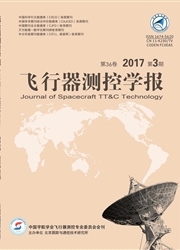

 中文摘要:
中文摘要:
基于引入无旋转原点可以克服春分点的固有缺陷的特性,在分析GCRS(Geocentric Celestial Reference System,地心天球参考系)与ITRS(International Terrestrial Reference System,国际地球参考系)之间基于无旋转原点的转换过程基础上,计算了IERS(International Earth Rotation and reference systems Service,国际地球自转与参考系服务)1996、2003、2010等规范所推荐的3组转换参数的具体数值及其差异,并以太阳系10个天体为例进行了参考系转换计算。结果表明:IERS 2003、2010规范中推荐的2组转换参数间的差异较小,对坐标转换的影响在0.5mas以内;IERS 1996规范中推荐的转换参数与另外2组转换参数间的差异较大,对坐标转换的影响在2.5mas以内。基于无旋转原点转换和基于春分点的岁差章动转换2种方法间的差异对坐标转换的影响,在IERS 2003、2010规范中不超过5μas,而在IERS 1996规范中由于未考虑框架偏差的影响导致差异较大。
 英文摘要:
英文摘要:
The introduction of Non-Rotating Origin (NRO) could overcome the inherent defects of equi-nox. According to the analysis of the NRO-based transformation method between Geocentric Celestial Reference System (GCRS) and International Terrestrial Reference System (ITRS) , this paper calculated the specific values of three sets parameters and their difference, which were recommended by International Earth Rotation and reference systems Service (IERS) Conventions 1996, 2003 and 2010. Then taken ten celestial bodies in solar systems for ex-amples, the reference system transformation based on NRO was calculated. The results show th a t the difference of the parameters calculation models between IERS Conventions 2003 and 2010 was very small. It led leaded to the difference of coordinate transformation results within 0. 5 mas , and the difference of the parameters calculation mod-els between IERS Conventions 1996 and other two Conventions was bigger, and led to the difference of coordinate transformation results within 2. 5 mas. The difference between equinox-based and NRO-based transformation meth-ods led to the difference of coordinate transformation results within 5 μas in IERS Conventions 2003 and 2010, while the difference in IERS Conventions 1996 was bigger due to not considering the influence of frame bias.
 同期刊论文项目
同期刊论文项目
 同项目期刊论文
同项目期刊论文
 期刊信息
期刊信息
